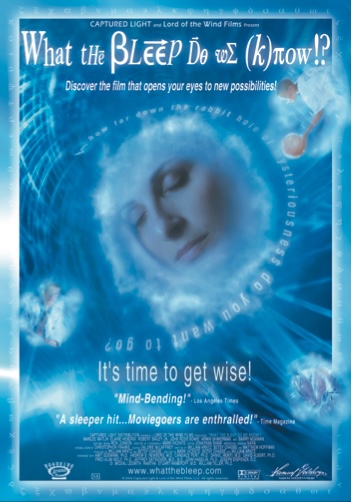BY MARK HAWTHORNE
When three filmmakers started out to make a small documentary four years ago, they could hardly imagine their labor of love would become a feature-length production and the biggest art-house hit of 2004. William Arntz, Betsy Chasse and Mark Vicente simply wanted to bring their ideas about the nature of reality into the mainstream and get the public talking. Their docudrama “What the Bleep Do We Know!?, ” (http://www.whatthebleep.com [http://www.whatthebleep.com]) which views consciousness through the lens of quantum physics, eventually won every independent film festival award it was nominated for, and it’s guaranteed to find an even larger audience now that it has been released on home video and DVD.
The film combines a host of storytelling techniques–including animation, computer-generated images and interviews with more than a dozen articulate scientists and thinkers–to explore the mind’s ability to directly participate in the creation of reality. We hear from such experts as David Albert, Joe Dispenza, Amit Goswami, John Hagelin, Stuart Hameroff, Miceal Ledwith, Daniel Monti, Andrew B. Newberg, Candace Pert, Jeffrey Satinover, William Tiller and Fred Allen Wolf. Also offering insights is JZ Knight, a 59-year-old woman from Washington State who, since 1978, has been channeling Ramtha, a 35,000-year-old warrior from Atlantis. He teaches the divinity of humans and the synthesis of science and spirituality. Many of those associated with “What the Bleep?” are Ramtha followers.
Among the ideas these physicists, biologists, neurologists, philosophers and scholars postulate are that matter is completely insubstantial, people can be addicted to emotions, and that time need not flow in one direction. The film’s most notable message, though, is the proposition that our perception of reality may be a mental fabrication. If this is true, then that perception can be transformed by simply altering the attitudes we hold about ourselves–attitudes that are often damaging to our self-esteem. Clinicians today call this technique cognitive behavior therapy, and it has become a popular method for treating a variety of emotional and behavioral problems, including depression, anxiety and substance abuse. The filmmakers, however, have taken their cue not from psychotherapy but from quantum mechanics, which states that observation can alter phenomena.
Weaving the interviews and other material together is a dramatic narrative starring Marlee Matlin as a dour professional photographer who leads an uninspired existence in Portland, Oregon. Matlin’s character, Amanda, relies on antidepressants to get her through each day and each job assignment. The film cleverly interjects Amanda into explanations of how the consciousness of the observer affects the reality seen, thus vividly illustrating each important point. The movie is unrated, but probably would come in at “PG-13.” Reviewers were either against it or loved it.
“What the Bleep?” expresses ideas that have been promulgated by a number of thinkers in recent decades. In The Tao of Physics (1975), for example, physicist Fritjof Capra ties Hinduism, Buddhism and Taoism together with Western science and notes how much quantum physics and metaphysics have in common. Deepak Chopra examines the link between physics and Hinduism in Quantum Healing (1989). In his 1995 book The Self-Aware Universe, Amit Goswami uses quantum physics to promote the theory that mind and matter both have their origins in consciousness, which he argues is the ground of all being. While the film does an admirable job of demonstrating this link, the science sometimes comes a little too fast to keep up with.
Moreover, it fails to mention that the founders of quantum physics, who developed the science a century ago, did not believe there was any connection between physics and mysticism. Ken Wilbur, author of Quantum Questions: Mystical Writings of the World’s Great Physicists (1984), asserts that although the founders of quantum physics–Niels Bohr, Albert Einstein, Werner Heisenberg, Max Plank, and others–were all mystics in their own way, they were virtually unanimous in declaring that modern physics offers no proof of mysticism or transcendentalism. Plank, for example, believed that science and religion deal with two very different dimensions of existence. (Plank is credited with inventing quantum physics, which tries to explain how subatomic particles work, in 1900.)
As pure cinema, “What the Bleep?” is by no means a stunning achievement. The acting is wooden and the humor is sophomoric. Also, many in the scientific community have derided the film’s simplistic approach to physics and, not surprisingly, its New Age pedigree. Yet one cannot deny its boldness, and that’s where it succeeds, challenging the audience to consider the nature of reality–which may explain why so many spiritually-minded thinkers have embraced it. With its blend of science and existential pondering, “What the Bleep Do We Know!?” is best as a shared experience and is guaranteed to inspire some engaging conversations.
